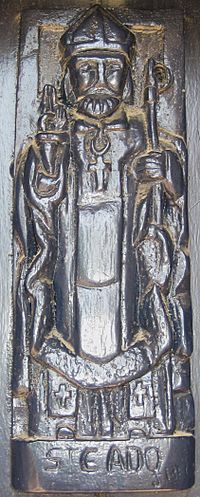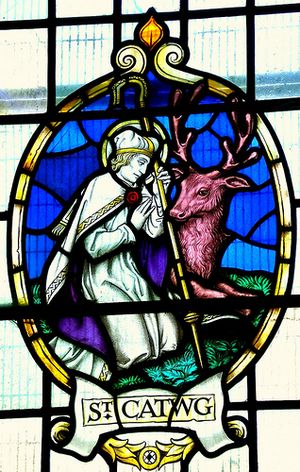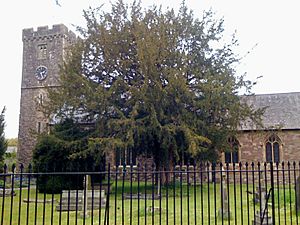Cadoc facts for kids
Quick facts for kids Saint Cadoc |
|
|---|---|

Saint Cadog as represented at Belz in Brittany
|
|
| Abbot | |
| Born | c. 497 traditionally Kingdom of Gwynllwg,, Wales |
| Died | 580, traditionally 21 September Beneventum (see text) |
| Venerated in | Roman Catholic Church; Eastern Orthodox Church Anglican Communion |
| Major shrine | Llancarfan Abbey (now destroyed) |
| Feast | 25 September, formerly 24 January |
| Attributes | Bishop throwing a spear, crown at feet, sometimes accompanied by a stag, a pig or a mouse |
| Patronage | Glamorgan; Llancarfan; famine victims; deafness; glandular disorders |
| Controversy | Place of death (see text) |
Saint Cadoc or Cadog (born around 497) was an important leader of the early Christian church in Wales. He was an Abbot (head of a monastery) at Llancarfan, a famous learning center in Glamorgan, Wales. Cadoc helped start many churches in Cornwall, Brittany, Dyfed, and Scotland. People called him Cattwg Ddoeth, which means "the Wise," because he shared many wise sayings. His life story is also special because it mentions King Arthur, making it an important old text about the legendary king.
Contents
Cadoc's Life Story
Cadoc's story comes from an old book called Vita Cadoci, written around 1086. It tells us about his life, though some parts might be more like legends than exact history.
Cadoc's parents were King Gwynllyw the Bearded and Princess Gwladys. His father was a local king in Wales. Gwynllyw wanted to marry Gwladys, but her father, King Brychan, said no. So, Gwynllyw and Gwladys ran away together! They escaped over the mountains.
Even before Cadoc was born, people believed he was special. Strange lights appeared in his parents' home, and their food cellars magically filled up. Cadoc was born in Monmouthshire around 497. An angel announced his birth and told a hermit (a person living alone for religious reasons) named Meuthi to baptize and teach him. A holy well appeared for his baptism, and it flowed with wine and milk!
When Cadoc was a baby, his father, King Gwynllyw, stole a cow from a monk named St. Tathyw. Tathyw bravely went to Gwynllyw to get his cow back. Instead of fighting, Gwynllyw decided to send young Cadoc to live with Tathyw. Cadoc learned Latin and got a basic education at Tathyw's monastery. This experience made him want to become a monk and a priest.
One day, while Cadoc was in Cardiff, he was being chased by an enemy. He ran into the woods and saw a white wild boar. The boar charged at him, but then it magically disappeared. Cadoc saw this as a sign from heaven. He marked the spot, and his uncle, King Pawl, gave him the land. This place later became the famous monastery of Llancarfan.
Cadoc's sister, Maches, was sadly killed by robbers. The monk Tathan built a church where she died.
As an adult, Cadoc chose to serve God instead of leading his father's army. He started his first monastery at Llancarfan. He then went to Ireland to study for three years. After returning to Wales, he studied with a teacher from Italy. He also traveled to Scotland and started a monastery there. Back at Llancarfan, his leadership helped it become one of the most important monasteries in South Wales.
Some stories say he went on a trip to Rome. It's more certain that he spent time in Brittany, a region in France. He lived on an island there, now called L'Ile de Cado, where he built a small church and a monastery. He worked hard to spread the Christian message. There are chapels dedicated to him in Brittany, and people pray to him there to help cure deafness. Many places in Brittany are named after him.
Llancarfan Monastery
The monastery at Llancarfan, also known as the "Church of the Stags," was founded by Cadoc in the late 400s. It was in Glamorgan, not far from the Bristol Channel. Cadoc built a monastery and a college there, which became a training center for many holy men.
The area was originally a difficult, marshy place. But Cadoc and his monks worked hard to drain the land and make it useful. They turned it into one of the most famous and beautiful religious places in South Wales. The monastery included a place for monks, a college, and a hospital.
After setting up the community, Cadoc went to Ireland to study and teach. When he came back three years later, he found the monastery in ruins. He made the monks work hard to rebuild it, even dragging timber from the woods. Two stags (male deer) came out of the forest to help them! This is why the stream next to the monastery is called the Nant Carfan, which means "Stag Brook."
Cadoc in Scotland
Around the year 528, after his father passed away, Cadoc is said to have built a stone monastery in Scotland. This was probably at Kilmadock, a place named after him, located north-west of Stirling. Near the old Kilmadock church ruins, there's a place called Hermit's Croft, where people believe he lived for seven years. Seven local churches were built in his name. It's also thought that Cadoc's monastery was near a hill called Mount Bannauc. People who followed Cadoc in Scotland were called "Gille Dog," meaning "servants of Cadog." This name later became surnames like Dog, Doig, Dock, and Doak.
Legends of Saint Cadoc
Cadoc and King Arthur
Cadoc had some disagreements with King Arthur. The old stories show Arthur as a great king, but sometimes stubborn. One story says that Cadoc protected a man who had killed three of Arthur's soldiers. Arthur demanded a herd of cattle from Cadoc as payment. Cadoc gave him the cattle, but when Arthur took them, they magically turned into bundles of ferns! Stories like this were often told in the Middle Ages to show that the church had special powers and should be free from the king's control. In later Welsh legends, Cadoc, along with Illtud and Peredur, is said to be one of the three knights who guarded the Holy Grail.
The church of Saint Cadoc's Church in Caerleon is built on the foundations of an old Roman army base. This place was also connected to the legends of King Arthur.
Other Interesting Stories
There was once a special place linked to Cadoc that was believed to have healing powers. However, this spot was lost around the year 1041.
Some writers have confused Cadoc with another saint named Sophias, a bishop in Italy. Because of this, some stories say Cadoc died in Italy. One legend tells how Cadoc was carried away in a cloud from Britain to a place called Beneventum. There, he was renamed Sophias and became an abbot, a bishop, and a martyr (someone who dies for their faith). A large church was built over his burial place.
Celebrating Saint Cadoc
In the 2004 edition of the Roman Martyrology (a list of saints recognized by the Catholic Church), Cadoc is listed among saints who died on September 21st. It says: "In the monastery at Llancarfan in South Wales, Saint Cadoc the Abbot, under whose name many monasteries in Cornwall and Brittany were established."
Even though September 21st is also the feast day for Saint Matthew, in Cardiff, Saint Cadoc's Day is traditionally celebrated on September 25th. In France, on the island of Saint-Cado, a big celebration called a "pardon" is held on the third Sunday in September. Sometimes, his feast day is also celebrated on January 24th.
See also
- Cambuslang
- Llancarfan, site of Cadoc's 6th century abbey
- St Cadoc's Hospital, Caerleon
- St Cadocs/Penygarn, electoral ward that also has a Saint Cadoc's church
- St Cadou
- St. Cadoc's Church, Glynneath
- St Cadoc's Church, Llangattock Lingoed
- Church of St Cadoc, Raglan, Monmouthshire



